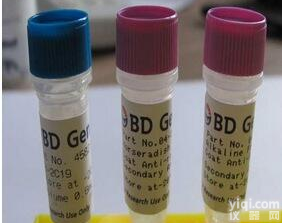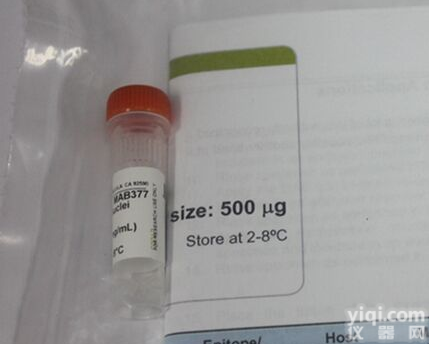英文名称 Aprataxin
中文名称 共济失调性眼球运动功能丧失相关蛋白AOA1抗体
别 名 AOA 1; AOA; AOA; AOA1; AOA1; Aprataxin; Aprataxin; Aprataxin homolog; APTX; APTX; APTX_HUMAN; Ataxia 1 early onset with hypoalbuminemia; Ataxia 1 early onset with hypoalbuminemia; Ataxia1 early onset with hypoalbuminemia; AXA 1; AXA1; AXA1; EAOH; EAOH; EOAHA; EOAHA; FHA HIT; FHA HIT; FHA-HIT; FLJ20157; FLJ20157; Forkhead associated domain histidine triad like; Forkhead associated domain histidine triad like; Forkhead associated domain histidine triad like protein; Forkhead-associated domain histidine triad-like protein; MGC1072; MGC1072.
共济失调性眼球运动功能丧失相关蛋白AOA1抗体
说 明 书 0.2ml
研究领域 神经生物学 表观遗传学
抗体来源 Rabbit
克隆类型 Polyclonal
交叉反应 Human, Mouse, Rat, Horse, Rabbit,
产品应用 IHC-P=1:100-500 IHC-F=1:100-500 (石蜡切片需做抗原修复)
not yet tested in other applications.
optimal dilutions/concentrations should be determined by the end user.
分 子 量 41kDa
细胞定位 细胞核
性 状 Lyophilized or Liquid
浓 度 1mg/1ml
免 疫 原 KLH conjugated synthetic peptide derived from human AOA1/Aprataxin
亚 型 IgG
纯化方法 affinity purified by Protein A
储 存 液 Preservative: 15mM Sodium Azide, Constituents: 1% BSA, 0.01M PBS, pH 7.4
保存条件 Store at -20 °C for one year. Avoid repeated freeze/thaw cycles. The lyophilized antibody is stable at room temperature for at least one month and for greater than a year when kept at -20°C. When reconstituted in sterile pH 7.4 0.01M PBS or diluent of antibody the antibody is stable for at least two weeks at 2-4 °C.
产品介绍 background:
Aprataxin is a nuclear protein, present in both the nucleoplasm and the nucleolus, which is a member of the histidine triad (HIT) superfamily. Aprataxin is involved in DNA single-strand break repair, mediating protein-protein interactions with molecules responding to DNA damage. Aprataxin contains three conserved domains: an N-terminal forkhead-associated (FHA) domain which mediates protein-protein interactions, a HIT domain that is similar to Hint, and a C-terminal zinc finger domain. Loss of function mutations in APTX, the gene encoding for Aprataxin, destabilize the Aprataxin protein and result in a rare neurological disorder known as ataxia-oculomotor apraxia, characterized by abnormal movements of the head and eyes. These mutations either target the HIT domain or truncate the protein N-terminal to a zinc finger.
Function:
DNA-binding protein involved in single-strand DNA break repair, double-strand DNA break repair and base excision repair. Resolves abortive DNA ligation intermediates formed either at base excision sites, or when DNA ligases attempt to repair non-ligatable breaks induced by reactive oxygen species. Catalyzes the release of adenylate groups covalently linked to 5'-phosphate termini, resulting in the production of 5'-phosphate termini that can be efficiently rejoined. Also able to hydrolyze adenosine 5'-monophosphoramidate (AMP-NH(2)) and diadenosine tetraphosphate (AppppA), but with lower catalytic activity.
Subunit:
Interacts with single-strand break repair proteins XRCC1, XRCC4, ADPRT and p53/TP53. Interacts with NCL. Interacts (via FHA-like domain) with MDC1 (phosphorylated).
Subcellular Location:
Nucleus, nucleoplasm. Nucleus, nucleolus. Upon genotoxic stress, colocalizes with XRCC1 at sites of DNA damage. Colocalizes with MDC1 at sites of DNA double-strand breaks. Interaction with NCL is required for nucleolar localization.
Tissue Specificity:
Widely expressed. In brain, it is expressed in the posterior cortex, cerebellum, hippocampus and olfactory bulb. Isoform 1 is highly expressed in the cerebral cortex and cerebellum, compared to isoform 2.
DISEASE:
Defects in APTX are the cause of ataxia-oculomotor apraxia syndrome (AOA) [MIM:208920]. AOA is an autosomal recessive syndrome characterized by early-onset cerebellar ataxia, oculomotor apraxia, early areflexia and late peripheral neuropathy.
Defects in APTX are a cause of coenzyme Q10 deficiency (COQ10D) [MIM:607426]. Coenzyme Q10 deficiency is an autosomal recessive disorder with variable manifestations. It can be associated with three main clinical phenotypes: a predominantly myopathic form with central nervous system involvement, an infantile encephalomyopathy with renal dysfunction and an ataxic form with cerebellar atrophy.
Similarity:
Contains 1 C2H2-type zinc finger.
Contains 1 FHA-like domain.
Contains 1 HIT domain.
Gene ID:
54840
Database links:
Entrez Gene: 54840 Human
Omim: 606350 Human
SwissProt: Q7Z2E3 Human
Unigene: 20158 Human
Important Note:
This product as supplied is intended for research use only, not for use in human, therapeutic or diagnostic applications.
xy-7671R NGFRAP1神经生长因子受体相关蛋白1抗体
xy-7672R NRH2死亡结构域蛋白NRH2抗体
xy-0046R Neuronal thread protein AD7c-NTP神经丝蛋白抗体
xy-0982R phospho-NFKB p65(Ser536)磷酸化细胞核因子抗体
xy-1335R Notch1跨膜受体蛋白Notch-1抗体
xy-3386R Phospho-NR1D1(Ser55 + Ser59)磷酸化细胞核受体Rev-Erbα抗体
xy-10044R Newcastle disease virus鸡新城疫病毒抗体
xy-1537R NADPH还原型辅酶Ⅱ/磷酸酰胺腺嘌呤二核苷酸抗体
xy-2012R NIT2NIT2蛋白抗体
xy-1517R NeuroD1神经细胞分化因子1抗体
xy-1417R NFAT2活化T细胞核因子1蛋白抗体
xy-2175R NMDAR1谷氨酸受体1抗体
xy-2590R NRSF/REST神经元YZ蛋白抗体
xy-2304R ARHGAP17神经细胞发育相关调控蛋白抗体
xy-1287R IKB alpha核因子κBYZ蛋白α抗体(IκB-α)
xy-3543R Phospho-NFKB p65(Ser276)磷酸化细胞核因子NF-κB p65抗体
xy-3544R Phospho-NFKB1(Ser932)磷酸化细胞核因子p50/k基因结合核因子抗体
xy-3447R Phospho-eNOS (Ser1177)磷酸化一氧化氮合成酶3(内皮型)抗体
xy-7917R NUCKS1核酪蛋白激酶和细胞周期蛋白依赖性激酶底物1抗体
xy-7937R NIFKNIFK蛋白抗体
xy-7938R phospho-NIFK (Thr234)磷酸化NIFK抗体
xy-8377R NFX1核转录因子X盒结合蛋白1抗体
xy-7763R NIR2膜磷脂转移蛋白1抗体
xy-12002R Neurotensin Receptor 1神经降压素受体1抗体
xy-12004R Neurotensin Receptor 2神经降压素受体2抗体
xy-11988R Neurabin 1神经组织特异性F肌动蛋白结合蛋白抗体
xy-11976R NOTCH1胞内活化的Notch1蛋白抗体
xy-11977R NCS1神经钙传感蛋白1抗体
xy-11978R NECAB1神经元钙结合相关蛋白EFCBP1抗体
xy-11974R NUMBL膜相关蛋白样蛋白NUMBL抗体
xy-11684R NPEPPS嘌呤霉素敏感性氨肽酶蛋白抗体
 共济失调性眼球运动功能丧失相关蛋白AOA1 / 共济失调性眼球运动功能丧失相关蛋白AOA1抗体
共济失调性眼球运动功能丧失相关蛋白AOA1 / 共济失调性眼球运动功能丧失相关蛋白AOA1抗体
 共济失调性眼球运动功能丧失相关蛋白AOA1抗体|Aprataxin抗体价格
共济失调性眼球运动功能丧失相关蛋白AOA1抗体|Aprataxin抗体价格
 Aprataxin抗体*共济失调性眼球运动功能丧失相关蛋白AOA1抗体FITC.PE
Aprataxin抗体*共济失调性眼球运动功能丧失相关蛋白AOA1抗体FITC.PE
 Anti-Aprataxin抗体,共济失调性眼球运动功能丧失相关蛋白AOA1抗体
Anti-Aprataxin抗体,共济失调性眼球运动功能丧失相关蛋白AOA1抗体
 Aprataxin抗体 共济失调性眼球运动功能丧失相关蛋白AOA1抗体
Aprataxin抗体 共济失调性眼球运动功能丧失相关蛋白AOA1抗体
 Aprataxin抗体 共济失调性眼球运动功能丧失相关蛋白AOA1抗体
Aprataxin抗体 共济失调性眼球运动功能丧失相关蛋白AOA1抗体
 共济失调性眼球运动功能丧失相关蛋白AOA1抗体
共济失调性眼球运动功能丧失相关蛋白AOA1抗体
 共济失调性眼球运动功能丧失相关蛋白AOA1抗体
共济失调性眼球运动功能丧失相关蛋白AOA1抗体
 共济失调性眼球运动功能丧失相关蛋白AOA1抗体
共济失调性眼球运动功能丧失相关蛋白AOA1抗体
 共济失调性眼球运动功能丧失相关蛋白AOA1抗体|Aprataxin优质现货
共济失调性眼球运动功能丧失相关蛋白AOA1抗体|Aprataxin优质现货
 共济失调性眼球运动功能丧失相关蛋白AOA1抗体
共济失调性眼球运动功能丧失相关蛋白AOA1抗体
 FITC标记的共济失调性眼球运动功能丧失相关蛋白AOA1抗体
FITC标记的共济失调性眼球运动功能丧失相关蛋白AOA1抗体